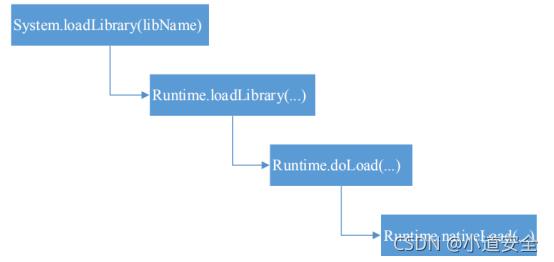在android中如何用Java加載解析so
理論基礎
so的加載是一種解析式裝載,這與dex有一定區別,dex是先加載進行優化驗證生成odex,再去解析odex文件,而so更像邊解析邊裝載,在加載過程中主要解析是load段。
下面主要是以java層的so加載進行從源碼上進行解析加載流程。
java層的so加載流程分析
System.loadLibrary入口點
在java層我們知道加載so文件是通過System.loadLibrary函數其實現的,下面就以其作為入口點進行分析它的調用關系和實現。
System.loadLibrary在的函數定義系統source\libcore\luni\src\main\java\java\lang\system.java的文件中。
下面是其函數定義實現。
//參數就是要加載的so文件名稱
public static void loadLibrary(String libName) {
//通過調用Runtime下面的loadLibrary函數實現
//函數有兩個參數,參數1是加載的so文件名,參數2 類加載器。
Runtime.getRuntime().loadLibrary(libName, VMStack.getCallingClassLoader());
}
Runtime的loadLibray解析
通過上面的System.java的loadLibrary函數我們需要繼續分析Runtime.java文件中的loadLibray函數的定義實現。
Runtime的loadLibrary函數在android系統中的位置是
source\libcore\luni\src\main\java\java\lang\Runtime.java文件。
下面是Runtime的 loadLibrary函數的定義實現源碼。
/*
* Searches for and loads the given shared library using the given ClassLoader.
*/
void loadLibrary(String libraryName, ClassLoader loader) {
if (loader != null) {
//通過加載器去查找要加載的so文件名
String filename = loader.findLibrary(libraryName);
//查找失敗
if (filename == null) {
// It's not necessarily true that the ClassLoader used
// System.mapLibraryName, but the default setup does, and it's
// misleading to say we didn't find "libMyLibrary.so" when we
// actually searched for "liblibMyLibrary.so.so".
throw new UnsatisfiedLinkError(loader + " couldn't find \"" +
System.mapLibraryName(libraryName) + "\"");
}
//加載so文件名
String error = doLoad(filename, loader);
if (error != null) {
throw new UnsatisfiedLinkError(error);
}
return;
}
String filename = System.mapLibraryName(libraryName);
List<String> candidates = new ArrayList<String>();
String lastError = null;
//循環遍歷文件路徑
for (String directory : mLibPaths) {
//文件路徑和文件名進行拼接
String candidate = directory + filename;
candidates.add(candidate);
if (IoUtils.canOpenReadOnly(candidate)) {
String error = doLoad(candidate, loader);
if (error == null) {
return; // We successfully loaded the library. Job done.
}
lastError = error;
}
}
if (lastError != null) {
throw new UnsatisfiedLinkError(lastError);
}
throw new UnsatisfiedLinkError("Library " + libraryName + " not found; tried " + candidates);
}
Runtime的doLoad解析
通過上面的Runtime的loadLibrary函數,我們看到加載so的函數是走到doLoad函數,那麼我們就需要繼續分析Runtime下的doload函數的定義實現。
Rutime下的doload函數在系統中的
source\libcore\luni\src\main\java\java\lang\Runtime.java文件中。
下面的代碼是Runtime的doload函數的定義實現。
private String doLoad(String name, ClassLoader loader) {
// Android apps are forked from the zygote, so they can't have a custom LD_LIBRARY_PATH,
// which means that by default an app's shared library directory isn't on LD_LIBRARY_PATH.
// The PathClassLoader set up by frameworks/base knows the appropriate path, so we can load
// libraries with no dependencies just fine, but an app that has multiple libraries that
// depend on each other needed to load them in most-dependent-first order.
// We added API to Android's dynamic linker so we can update the library path used for
// the currently-running process. We pull the desired path out of the ClassLoader here
// and pass it to nativeLoad so that it can call the private dynamic linker API.
// We didn't just change frameworks/base to update the LD_LIBRARY_PATH once at the
// beginning because multiple apks can run in the same process and third party code can
// use its own BaseDexClassLoader.
// We didn't just add a dlopen_with_custom_LD_LIBRARY_PATH call because we wanted any
// dlopen(3) calls made from a .so's JNI_OnLoad to work too.
// So, find out what the native library search path is for the ClassLoader in question...
String ldLibraryPath = null;
if (loader != null && loader instanceof BaseDexClassLoader) {
ldLibraryPath = ((BaseDexClassLoader) loader).getLdLibraryPath();
}
// nativeLoad should be synchronized so there's only one LD_LIBRARY_PATH in use regardless
// of how many ClassLoaders are in the system, but dalvik doesn't support synchronized
// internal natives.
synchronized (this) {
return nativeLoad(name, loader, ldLibraryPath);
}
}
總結
從以上的源碼實現流程分析,我們可以看出Android在java層加載so的接口是System.loadLibrary(),通過層層遞進關系從而實現java層的加載so。
下圖是詳細的java層加載so函數的調用關系。

到此這篇關於在android中如何用Java加載解析so的文章就介紹到這瞭,更多相關Android 加載so內容請搜索WalkonNet以前的文章或繼續瀏覽下面的相關文章希望大傢以後多多支持WalkonNet!
推薦閱讀:
- Android源碼探究之BaseDexClassLoader的使用
- Java源碼解析之ClassLoader
- Android 中的類文件和類加載器詳情
- ClassLoader雙親委派模式作用詳解
- Java日常練習題,每天進步一點點(31)